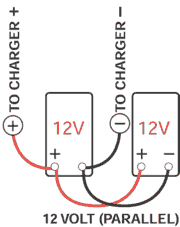I have learned a good bit about batteries in the Navy, so I’ll chime in. There a lot of good points above. Yes, paralleling the batteries will raise the lower voltage. Yes, this can help the electronic chargers see it better. Yes, this a very large current draw on the good battery. This is actually what’s happening when jump starting, but the running engine doesn’t care because it has a charging system going. The goal then is not to raise the voltage of the low battery, but supply the needed starting current directly through the cables. If the low battery is significantly discharged or bigger, charging current is high enough to limit the starting current drawn, which is why you then have to let it sit a minute to let the voltage come up some so less current gets directed to charging.
The goal with the OP’s idea is not to supply this current, but just raise voltage seen by the charger. This can be achieved one of two ways. First, parallel the batteries long enough to charge it some, then disconnect them and fire up the charger. Keep in mind that the terminal voltage on any battery will be higher right after charging then settle somewhere lower after 30 min to 12 hrs, depending and different factors, so start charging quickly for best results.
The other option is to have your charger ready, parallel the batteries, then immediately power up the charger. Once the charger is going, disconnect the batteries and see if the charger stays ‘fooled.’
The first option will help raise voltage more so the charger will accept it better once disconnected. Might be the better option if the battery is ‘more dead.’ This does cause more uncontrolled charging current, which isn’t great for the battery. They like controlled currents at lower rates. Even chargers that use higher desulfating currents are nowhere near what passes through jumper cables. While not going to kill a battery, it wouldn’t be my first option. (If you could insert a large resistor in the circuit that would withstand and limit the higher currents to maybe 40-50A, that would be best.)
The second option seems better. The main reason is that it will limit excess charging currents. If done right, it would be less than when jumping a car. The downside is that some chargers may stop charging after disconnecting if they see the battery voltage drop too much, especially if it’s larger or deeply drained.
I guess another option is to just put it in a ski (mower, car, etc) and jump it like someone mentioned. Once running, the charging system will do the work and charge it up. As long as the battery isn’t a complete 0V open circuit, it will act as the needed energy sink the charging system needs. If the battery is really low and you don’t want to run the engine that long, just run it enough to bring voltage up some and then hook up the charger.
Someone mentioned sparking. This is typically not a problem. It is true though that there is a small chance of explosion, which is why you connect to the dead ground last when jumping a car and not the negative terminal. Proceed with caution, consider safety glasses. If you have a large jumper, like a clamp and short heavy cable from old jumper cables or a welder (or just a large thick clamp), then that would greatly reduce that risk by moving the spark away from the battery.
You should only parallel batteries for a short period in any case, especially if the good battery isn’t significantly bigger. The hour or whatever originally mentioned is too long I think. Yes, the charger can charge them both together, but car batteries aren’t designed to have any sort of deep discharge. Deep cycle batteries aren’t designed to discharge at high currents. In either case, you are stressing your battery in a way that will affect its longevity. Charging in parallel isn’t the best either, as they will try and charge at different rates, even if the same size and age, due to individual differences. That’s why multi-bank chargers are designed as they are. (Yes, boats, RVs, etc have multiple batteries charging together, but there isn’t a great alternative for installed battery banks. If they could be charged individually, it would be better.) This is even more important when it’s different size batteries, or different types (wet, AGM), as they have different terminal voltages and REALLY need to be charged at different voltages. (AGM does not like standard charging voltage!) The point of this part is don’t try to equalize and then charge them both together. Connect them just long enough to achieve your goal of charging the one. Might want to top off the other one after too. In any case, the dead battery’s life has been affected and you will have to address it down the road, though maybe not for a while.
I think the best idea mentioned was to use a simpler charger that can be manually adjusted and doesn’t have all the electronic interlocks. Set it to charge at a steady 1.5-3A and wait for the battery to charge enough to hold a voltage that the smart charger will accept. Then swap to that and let it finish. It will charge it at the right rates to maximize battery health. If there does happen to be a shorted cell or another issue, it should find it and tell you.
Speaking of desulfating, I recommend getting a charger that will do this. It’s the electrical version of shaking the crap out of the battery. The sulfates that have built up will be driven off the plates to some extent. This will restore some capacity in a well used battery, but never to 100% because of some sulfates that remain and the material loss that occurs during sulfates building up and falling off.
I know this was long, but hopefully it was helpful. Thanks to the others for bringing up good ideas. Shout out if you think of something else. I know we all hate losing cash and water time due to dying batteries!


